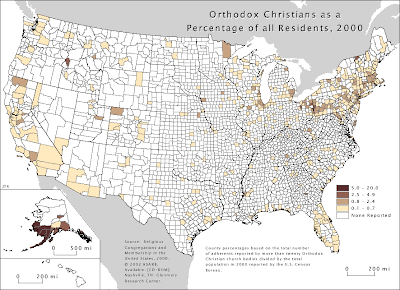Any pilgrimage to the "old" Orthodox countries is not complete if one does not visit some of the historical Churches built with much faith, dedication and love by our forefathers. Who can go to Constantinople and not visit Hagia Sophia, who can go to Thessaloniki and not visit the Church of Saint Demetrios, who can go to Kiev and not visit Lavra Pecerskaya, who can go to Romania and not visit the monasteries of Bukovina? These gems, preserved with many sacrifices through the centuries, continue to attract admirers, not only among the Orthodox, but also from people of other religious beliefs. They have something to say beyond the stone and the crafts, something spiritually deep that transcends their exterior beauty.
Why do I mention all this you may ask? The answer is simple, because living as an Orthodox in America I miss the churches from the old country. With few notable exceptions most of the Orthodox Churches in America do not even remotely resemble with a traditional Orthodox structure. We can invoke the lack of money, we can invoke the lack of engagement of the faithful, but the result is the same, we have started to loose the meaning of a traditional Church sacred space.
Because we live in a soup of thousands of different so called Christian denominations, we, the Orthodox, are in danger of loosing our identity that was so dearly preserved across the centuries by generations of martyrs. You hear people asking nowadays: why do we need to build traditional Churches? Why do we need domes, vaults apses and the sort? This is a waste of money; a cheap square building with generous space for pews should be enough to worship God!
Nothing can be more wrong than this. An Orthodox worship space cannot be conceived without these features. The domes, vaults, apses and icons are all intimately and permanently attached to the idea of being Orthodox. They are not just simple architectural elements, stripped of any essential significance like other human creations, but rather they are eternal and true expressions of the One and Holy Spirit of the Orthodox Faith. Nothing in the Orthodox sacred space is done without due consideration, nothing is superficial, but all has a meaning and a distinct purpose.
All the architectural elements are meant to introduce the faithful that enter therein in a state of prayer and heavenly admiration. The domes have been created using the pattern of the heavens that stand above us expressing through their majesty the Byzantine idea that Church has a world-wide mission. The vaults and the apses represent the rainbow, the covenant between God and Noah, but also the loving embrace of Mother Church. This is why in the Apse of the altar you always find represented the Mother of God, spreading her arms toward a humanity in need of her divine love and care. The icons that cover every inch of the walls represent true windows to the Kingdom of Heaven as they reveal to the faithful the transfigured world depicted in them.
Even in the worst times of war and suppression, the Churches were adorned with gold and most precious materials and craftsmanship, because the space of the Church is a representation of the Jerusalem from above, the Kingdom of heaven where even the poorest man on earth, if has faith, can enter and rejoice as a king in union with Christ the King of all! The Church building itself is a promise for a better world where nothing is missing, where everything is fulfilled. We adorn the Churches not for the pride of men, but as a promise of the future life and Kingdom.
Knowing all this we come to understand that the closed space of the Temple opens in fact thousands of doors to the other world above, a world that awaits us to join them into eternal life.
Through our traditional architecture we have something important to communicate. Now, more than ever, the Orthodox architecture is not a simple "nice to have" but is a "must". We are called to make again history today, to be brave and visionary builders like the emperors of Constantinople. Of course we don't have their means, but that does not imply that we need to abandon our traditions. One single person cannot do much, but as a community we can accomplish together so much more. We have to wisely seek the balance between tradition and resources so we can create something that will meaningfully express and preserve our wonderful heritage.
Above all we need to understand that nothing, and especially a Church, can be built without sacrifice, without reassessing our priorities in life. The churches of old were built on the sacrifice of our martyrs; the churches today have to be built on the sacrifice of our frivolous pleasures and the re-channeling of our resources toward what really matters for us today and for our children tomorrow. Only upon this communal sacrificial act we'll be able to build a Church that will endure, uniting us all into Christ our God.
Source


No comments:
Post a Comment